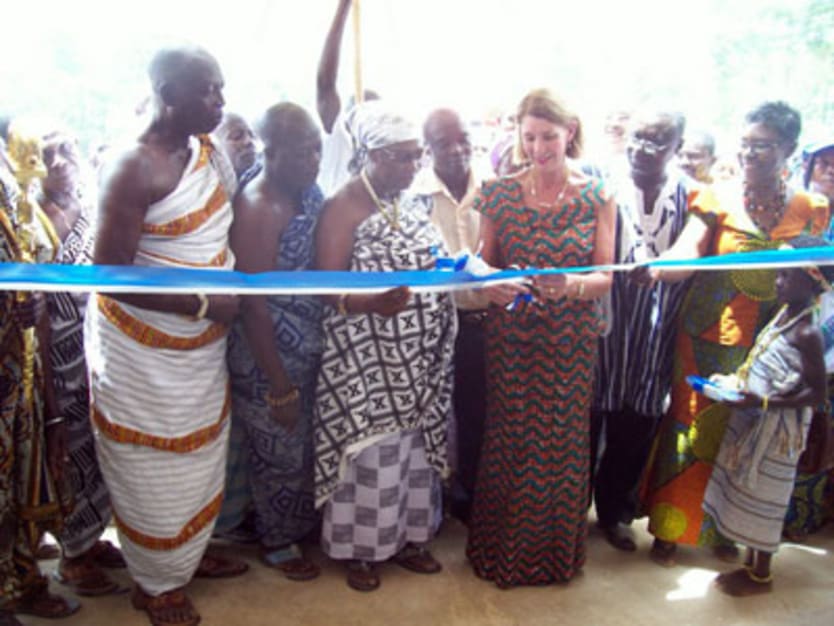
The Hunger Project is proud of its integrated approach to development challenges such as poverty, health care and access to food - and it is looking for partners to help impoverished communities help themselves.
In its field work, the Hunger Project emphasizes the mobilization of local communities, the partnerships with local government, and women's empowerment. Part of the nonprofit's strategy - used in Africa, Latin America and South Asia - is to organize clusters of villages to manage anti-poverty programs focused on everything from agriculture to banking.
In the coming years, the Hunger Project plans to focus on three key priorities, according to Jill Lester, the Hunger Project's chief executive. They are: building strong partnerships, assessing the impact of its projects, and spreading awareness of the group's work.
Lester, who became the Hunger Project's CEO in 2008, spoke with Devex about the Hunger Project's strategic partnerships.
What types of partners is the Hunger Project looking for?
We are certainly looking for partners at a whole range of different levels. … The Hunger Project has a very integrated model. While hunger and poverty is clearly our first priority, we also believe that the issues are all interconnected. We are helping people with basic education, with literacy skills, with health needs, with birthing clinics, with a food bank so that they can store their food, etc.
We would like to work more with a whole range of different sectoral partners. While we have developed fundamental skills in each of those sectors, we would certainly welcome working with partners that are specialists in some of those areas that I've just mentioned - education, health, nutrition, water, sanitation - to further entrench that sustainability that we're talking about.
We would also of course be interested in funding partners. We would be interested in partners that might work with us in terms of management and evaluation. We're very broad, but I would say that on the ground we're specifically interested in sectoral partners. We're working with the Ford Foundation in India and Uganda. We're working with Monterrey Institute of Technology in Mexico. They help the people in the villages in which we're working develop their business plans so that they're not coming up with the same industry as everyone else, but that they might have a niche. We're working with the Environmental Defense Fund in India to bring greater climate change awareness to the elected women representatives in India that we're working with. We're working with the Ministry of Health in Malawi. They're helping us with the distribution and procurement of treated bed nets. Those are just some of the examples. One of the wonderful things about being so integrated is that we have so many places that we believe we could work very effectively with other people.
How should organizations interested in working with the Hunger Project approach you?
It depends on where they find themselves. If they are U.S.-based, clearly we'd be very keen to hear from them here. We have also a range of what we call partner countries in the Netherlands, Australia, U.K., Sweden and Canada. If we were talking about organizations in any of our partner countries, they should approach the local THP office there. If we were talking about organizations that may have their headquarters or their people in any of the program countries, then they should also feel free to approach our country directors.
Sometimes it's a combination, of course. For example, I might meet somebody here and then they might say, "Well, I think the best way forward would be for my country director to meet your country director in Uganda" - or wherever it might be. So we are very flexible, and we need to be amenable to whatever works best and is most practically.
Does the Hunger Project provide grants, contracts and/or know-how to those working in the field?
We have a bit of a mix. In some countries, we work with local not-for-profits, but that's a little different from providing grants. We actually provide grants to a couple of organizations that have methodologies similar to us in Latin America, but at the moment we're not looking to extend those relationships. We're not really a grant-making body.
In India, when we're doing the capacity training of those elected women representatives, we do that by working with a range of local not-for-profit organizations on the ground. We believe it's much more locally relevant, for example, to work with local organizations in, say, Rajasthan who speak those languages, who understand the situation from which the women are coming.
One thing I should say is that we believe very strongly that we shouldn't really employ expatriates in the Hunger Project. So all of our local staff, in every program country in which we work, is always nationals of that country.
What are some of the key characteristics of projects you are willing to support, when it comes to region, sector, project focus, the type of partners, cost, etc.?
We have what we believe to be a very sustainable and proven methodology, so we would not want to damage the integrity of that model by moving too far beyond the work that we believe is the way that works best. Beyond that, we are very flexible. The great thing about an integrated model is that there are so many different ways in which we would be able to see ourselves work with partners.
In Ethiopia, for example, last year we worked with Rotary International to provide clean water to one of our "epicenters" in Africa. But we don't just go into a community and say, "Here's the pipe, and we'll just dig the well for you or lay the pipe." This is very much a partnership.
When we talk partnerships, it isn't just partnerships with funding organizations or NGOs. It's very much a partnership with the people we're working with, and it could be none other than a partnership that would have an outcome of self-reliance with those village partners. So, we would not really want to accept gifts of things that would be installed or provided, because we don't believe that is a path to self-reliance. What we would like to do is work with people that might help us say, "Well, the best place you could lay the pipe is here, and we'll provide you with the information or knowledge or materials that might not be available locally."
But the labor and the skills would still be coming from the people. That way, if something went wrong with the pump, they would know how to fix it. It's about a sense of ownership, as well. It's not just a practical matter of fixing it. People feel amazingly proud of things that they believe they've really worked upon and worked with someone on.








